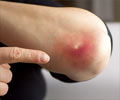Antibacterial therapy and contact with infected people or their pets can lead to re-infection and development of Multi Drug Resistant MRSA

‘Infected or colonized people and companion animals shed MRSA into the home environment, which then re-infects household members undergoing Antibotic therapy and can develop into Mult-Drug Resistant MRSA (Methicillin-Resistant Staphylococcus Aureus)’





Treatment with Mupirocin, an antibiotic used to treat skin infections and to prevent the nasal spread of MRSA from sneezes, is weakly associated with Mupirocin resistance in the household environment. That "could complicate decolonization efforts that rely on the use of nasal mupirocin ointment," said Mr. Shahbazian, who conducted the study while finishing his masters in public health at Johns Hopkins Bloomberg School of Public Health, Baltimore. ("Decolonization" refers to treatment to eradicate potentially disease-causing bacteria from human carriers.)Additionally, Mr. Shahbazian said that 100 percent of MRSA isolates the investigators obtained from rural homes were multi-drug resistant, "suggesting living in a rural household may be a risk factor for multi-drug resistance.
"We also found the presence of domestic pets was associated with multi-drug resistant MRSA in the home environment, while the presence of unwanted pests, such as mice or cockroaches, was associated with non-multi-drug resistant MRSA strains," said Mr. Shahbazian.
In the study, the investigators collected samples from the home environments and pets of households enrolled in a large randomized controlled trial, which took place over a 14 month period. They tested whether household-wide efforts to eradicate MRSA -- which included daily use of nasal mupirocin ointment and chlorhexidine body wash--were successful in reducing recurrence of MRSA among adults and children who had previously been diagnosed with a MRSA skin or soft tissue infection. They repeated sampling in 65 homes three months after the residents had been treated for MRSA, or, as a control, after they had been educated about MRSA.
"Based on the evidence, we strongly suspect that environmental contamination of the home with MRSA contributes to recurrence," said Mr. Shahbazian. The investigators also suspect that household-wide selective pressures on the home environmental reservoir of MRSA promote persistence of multi-drug resistant strains. "We hypothesize that infected or colonized people and companion animals shed MRSA into the home environment," which then re-infect household members.
Advertisement
The investigators are involved in One Health research. One Health examines health problems from a multidisciplinary perspective that includes physicians, veterinarians, environmental experts, and others.
Advertisement
Source-Eurekalert















